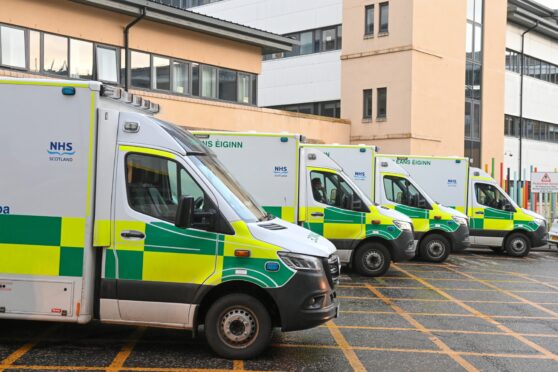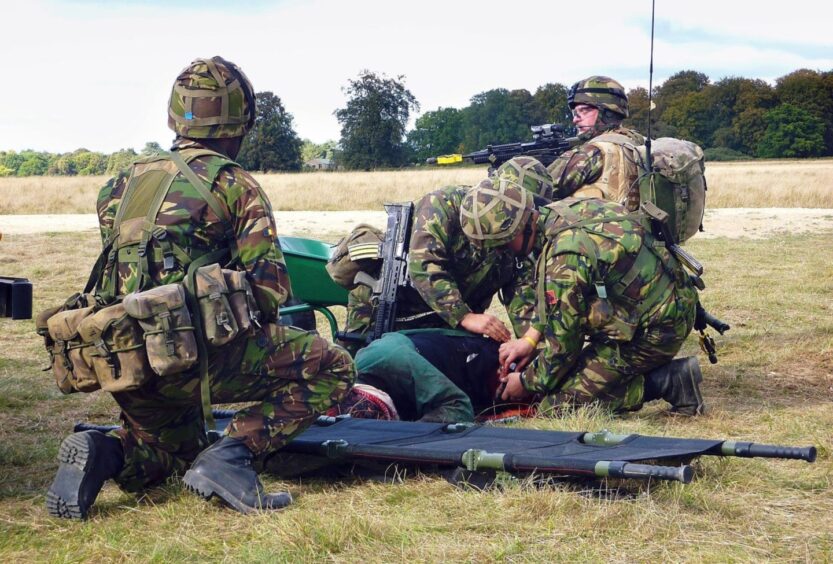
Ambulance paramedics could be trained in military techniques to keep sick and injured patients alive while they queue for hours outside hospitals.
A leading expert in treating patients in remote locations is calling on the Scottish Ambulance Service to train its emergency workers in a range of medical skills called prolonged field care (PFC).
The skills evolved from medic training learned in military conflicts, humanitarian missions, and disaster responses. The proposals are now being considered by the College of Paramedics, which sets training standards. The call comes as it emerged last week one patient was left waiting in an ambulance outside A&E in Ayrshire for 15 hours. A total of 700 ambulances were left stuck outside A&E in just one week.
Meanwhile, a BBC investigation found one in 10 ambulances were waiting for almost two hours outside A&E departments in the week up to December 4. At one point in their investigation they found 14 ambulances queuing outside Edinburgh Royal Infirmary’s A&E. And, on Thursday, 12 ambulances with patients were stuck outside Kirkcaldy’s Victoria Hospital.
The call to introduce PFC to Scottish ambulance emergency staff comes from Aebhric O’Kelly, a critical care paramedic and Dean Emeritus for the College of Remote and Offshore Medicine Foundation.
He said: “Outcomes for patients are diminished in long, protracted waits outside hospitals. There are obvious parallels with sick and injured in military settings.
“Using prolonged field care, that is essentially austere emergency care principles, should be adopted by Scottish and other UK services. They include preventing patients developing pneumonia, infection, blood clots, and bedsores which can start within 30 minutes.”
Writing in the Journal of Clinical Practice he says: “The situation in UK civilian practice is far removed from that of special forces deployed in hostile areas. However, with patients now spending longer and longer in the back of ambulances, waiting to disembark at hospitals running over capacity, it may be time to embrace the principles of PFC (prolonged field care).”
Research shows that patients who wait more than five hours in emergency care before admission to hospital have a heightened risk of death from any cause within the next 30 days.
Tracy Nicholls, chief executive of the College of Paramedics, said the college would be looking into introducing PFC. She said: “Paramedics rush sick patients to hospital A&E units then find they can wait for hours outside.
“They cannot be admitted because there are already sick patients inside and no free space.
“Our paramedics were trained to care for patients in situations where they were aiming for a 15-minute target turnaround. Who does that now in the UK?
“Now hours pass where you can get two or even three different shifts of paramedics looking after the same patients in ambulances outside hospitals. They cannot be admitted because there are already sick patients inside and no free space.”
She highlights the danger to patients trapped in long evacuations into A&E. “Mattresses patients use in ambulances are not designed to avoid pressure sores and there are risks of infection and other consequences of delayed admission to A&E,” she adds.
“Queuing for hours is not new but the huge scale of it is, and has become normalised.
“The impact is not just on patients who are our prime concern, but the impact on paramedics themselves because they fear patients deteriorating or dying.
“Everyone is in this job because they care and want to save and improve lives. Sadly, the working life expectancy of a paramedic university graduate is seven years, before they burn out or leave.”
The Scottish Government said: “This is an operational matter for the Scottish Ambulance Service (SAS). We are determined to ensure there are no unnecessary delays in transferring patients to hospital. We work closely with health boards and SAS to ensure emergencies are urgently responded to. Patient safety remains our top priority, and we apologise to anyone who has experienced long waits when contacting the ambulance service. We continue to invest in supporting staff and patients, including a record number of additional staff (1,388) since 2020, with a further 317 to be recruited in 2023/24.”
The Scottish Ambulance Service said it was not currently considering adopting this training. It said: “Our focus remains on working with health boards to minimise delays for patients and crews at hospitals. Additionally we are using innovative solutions to provide alternative routes of treatment, freeing up ambulances and reducing pressure on A&Es.”
What is prolonged field care?
Prolonged field care was first adopted by the US military’s Special Operations medical community 10 years ago.
It is designed for medical professionals working in remote, austere and challenging places caring for a critical casualty for a long time.
The aims are to reduce the patient’s chances of developing, or worsening from, complications including infections, pneumonia hastened by not being able to cough properly, blood clots from not moving limbs, pressure sores which can begin to develop in 30 minutes and more.
Infection is something that must be addressed very quickly and there is an 8% increase in mortality for every hour of delay in giving antibiotics.
Patients with Parkinson’s, epilepsy and other illnesses where medication must be given at the right time, need close monitoring.
Hypothermia is also a risk and affects blood flow. Left untreated, hypothermia can lead to complete failure of the heart and respiratory system, increasing the risk of death.
The need for paramedics to provide what is called austere care in the back of ambulances outside hospital emergency units is increasing.

Enjoy the convenience of having The Sunday Post delivered as a digital ePaper straight to your smartphone, tablet or computer.
Subscribe for only £5.49 a month and enjoy all the benefits of the printed paper as a digital replica.
Subscribe © PA
© PA